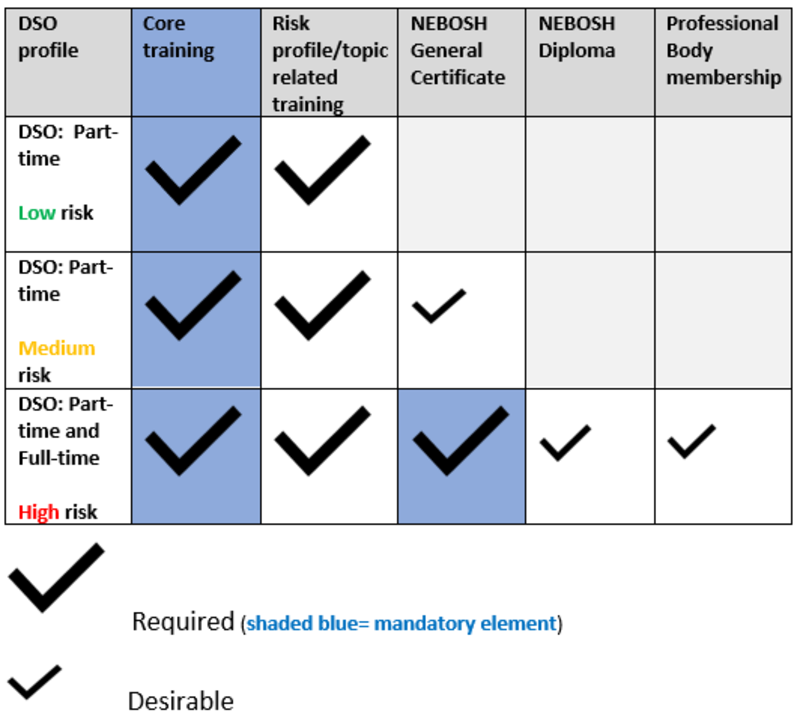Role-related training and competency frameworks
It's a legal requirement that we all have appropriate safety training which must be relevant to our roles and match the risks of our activities
Three role-related training and competency frameworks have been approved by the Safety Executive Group (SEG). The roles are departmental safety officers (DSOs), supervisors/line managers and leaders (executives and senior managers). These frameworks set out the appropriate training and competencies for those roles.
Dr Markos Koumaditis, Director of Human Resources: 'Creating a self-development culture with clear accountability lies at the heart of the three training and competency frameworks. These frameworks are building upon current good practice across the University and can be helpful for both awareness-raising and skills/competencies development.'
The University is a large and complex organisation with a vast range of activities and departmental risk profiles. These role-related frameworks set out a basic minimum level of training, with additional training added as needed based on the corresponding risk profile.
Training and competency have slightly different meanings. Training is learning and can be delivered in a number of formats, including detailed formal, face-to-face, eLearning, toolbox talks and on-the-job. While having the appropriate training is crucial, completion alone doesn't guarantee your competence to safely perform a specific task in the workplace.
Training, along with knowledge, experience and skills, helps develop the necessary proficiency. An individual’s level of competence only needs to be proportionate to their job, place of work and associated risks.
The departmental safety officer has a role of competent advisor and their duties are set out in University policy. This framework is designed to ensure that departmental safety officers are able to provide consistent, competent and confident health and safety advice to heads of department, staff and students.
In order for a departmental safety officer to fulfil their role effectively they must be allowed sufficient time and resource. Many departments with lower risk profiles combine the role of departmental safety officer with other roles such as facilities or administrative roles, so can be considered as part-time DSOs.
To undertake your role as DSO you must:
- register with the Safety Office. This includes initial registration on appointment, by emailing enquiries@safety.ox.ac.uk, and confirmation of registration on completion of core DSO training, which should be completed within 12 months of registration
- undertake additional training and accredited qualifications in accordance with
- the departmental risk profile
- the DSO category
- complete at least two annual continual professional development activities, including:
- one POD (People and Organisational Development), Safety Office or externally provided H&S training course
- one other development activity, for example a table top exercise to test out specific emergency procedures or participation in a business continuity exercise
To find out your appropriate role-related training please follow the steps below:
Identify which broad indicative risk category applies to you by discussing the most appropriate risk category with your divisional or area safety officer, with reference to the table below and divisional and departmental H&S risk registers. The Safety Office will make the final decision on the risk category where necessary.
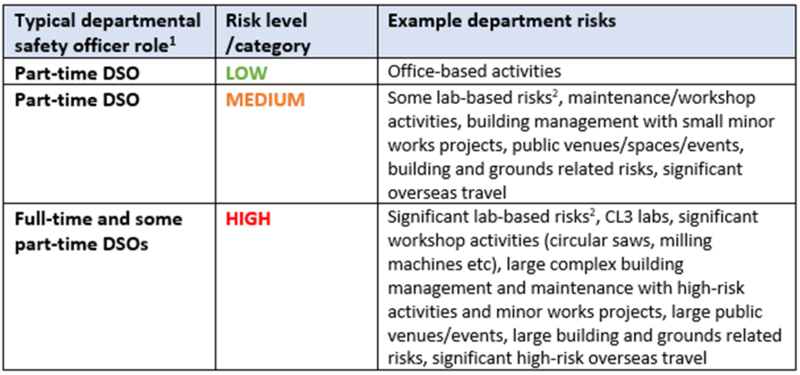
2 May include biological, radiation, laser and chemical risks.
Core training
- University DSO modules 1, 2, 3
- online courses:
Refresher training is required every three years.
Topic-related training
There are a range of topic-related training courses you need to complete depending on the risk profile of your department (for example chemical safety or manual handling) and any other safety-related roles you undertake (such as fire officer or biological safety officer). Refresher training is recommended every three years.
Professional qualification for DSO in high-risk departments
NEBOSH qualifications (National Examination Board on Occupational Safety and Health) are globally recognised and taken by people working in all types of industries. The General Certificate and Diploma are aimed at people seeking a career in health and safety. Equivalent courses can be agreed in consultation with the Safety Office, who also run annual NEBOSH courses.
All DSOs have the option of attending an NEBOSH Award or IOSH (Institution of Occupational Safety and Health) Managing Safely course if they would like a shorter introductory qualification.
The following competency-related factors and behaviours can provide useful points for discussion with line managers and ongoing development. Some will be important considerations in the recruitment process, particularly for departments with medium and high risks, and some can be gained through on-the-job experience.
- Experience of applying knowledge in relevant situations
- Ability to recognise compliance and breaches
- Ability to work in accordance with training and documented procedures
- Ability to undertake the necessary duties
- Exhibits approachable, reasonable and responsible behaviour
- Sufficient time, resources and authority to undertake the role
Managers and supervisors have responsibility for the health and safety of those they manage the activities of on a day-to-day basis, as set out in University policy.
A University safety instruction (I2/25) was issued on behalf of the Safety Executive Group in May 2025. This instruction reiterates the core training required of supervisors and line managers
An implementation toolkit has also been provided, outlining implementation responsibilities, actions required of divisions and departments, assurance exercises and further support, materials and resources.
The supervisors and line managers framework sets out the arrangements to achieve competent supervisors and line managers across the University who understand their health and safety responsibilities and are equipped to carry them out, in accordance with the Universities Safety and Health Association's Management Standard. This includes managers who manage a number of teams within a department, but who are not responsible for a department’s strategic health and safety direction. Senior managers and executives are covered separately.
A light touch will be appropriate for supervisors and line managers in low-risk contexts. However, where you're supervising or managing staff/students undertaking medium-to-high-risk activities they need to be more developed in their understanding of safety management as well as the topic areas of specific risk.
To find out your appropriate role-related training please follow the steps below:
Identify which broad indicative risk category applies to the area you supervise/manage by discussing the most appropriate risk category with your line manager. Take advice from the appropriate divisional or area safety officer and with reference to divisional and departmental H&S risk registers. The Safety Office will also provide advice if required.
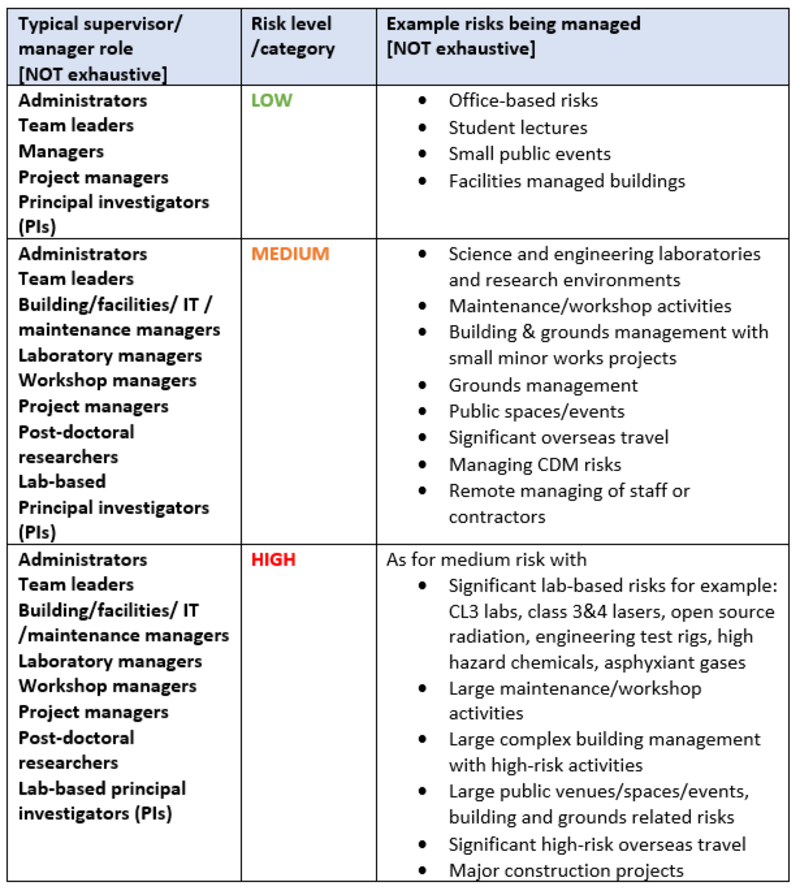
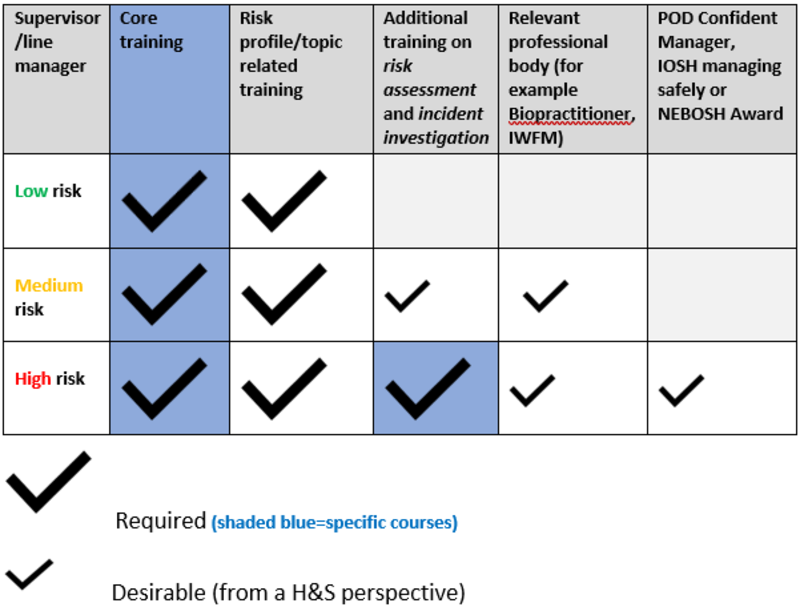
IOSH = Institute of Safety and Health. IOSH Managing Safely gives managers and supervisors the knowledge and skills they need to manage health & safety within their teams. It covers responsibilities for health & safety, hazard identification, assessing and controlling risks, accident investigation and measuring performance.
NEBOSH = National Examination Board in Occupational Safety and Health. NEBOSH Award-level qualifications provide a general understanding of health and safety principles and practice.
Core training
- Health and Safety Management for Supervisors and Line Managers - eLearning
- Familiarisation with the People and Organisational Development's Managers' Toolkit
Refresher training is required every three years.
Topic-related training
There are a range of topic-related training courses you need to undertake depending on the risks associated with your area (for example lab safety or building management). You can contact your departmental/divisional/area safety officer or the Safety Office for further discussion on what may be relevant on an individual basis. Refresher training is recommended every three years.
[eLearning modules are currently under development for supervisors/managers in specific environments, such as managing laboratory-based or building-related risks]
The following competency-related factors and behaviours can provide useful points for discussion with line managers and ongoing development. Some of these can be gained through on-the-job experience.
- Leads by example in the promotion of a positive safety culture
- Participates in arrangements for managing health and safety locally
- Ability to plan, implement and monitor policies and procedures locally
- Allows sufficient time and resources to operate safely
- Ability to undertake the necessary duties
- Ability to recognise danger and take action
- Exhibits reasonable and responsible behaviour
There's a wide-ranging legal responsibility on organisations to ensure the health, safety and welfare of all their employees, as well as the health and safety of others (such as students and members of the public). This responsibility is owned by the University. Legal liability lies with the most senior person in each functional unit, with the Vice-Chancellor having ultimate accountability.
This framework sets out the training and information that executives and senior managers must have to enable them to fulfil their duties. This applies to the governing body, leadership/executive team, and senior managers in accordance with the industry sector standard.
Below is a Health and Safety Briefing Pack, along with a 1-page Aide Memoire, to support heads of department in their key role in the University management system. The departmental and divisional safety officer should brief the head of department on the pack's contents, and there is guidance on how to do this below.
A version of the Aide Memoire is available for faculty board chairs. Please contact the Safety Office or your divisional safety officer if you wish to receive this version.
Head of Department Health and Safety Briefing Pack
Head of Department H&S Briefing Pack - guide for DSOs (and DivSOs)
The table below sets out minimum standards of training and information. The final column indicates externally-accredited qualifications which are encouraged where identified as appropriate.
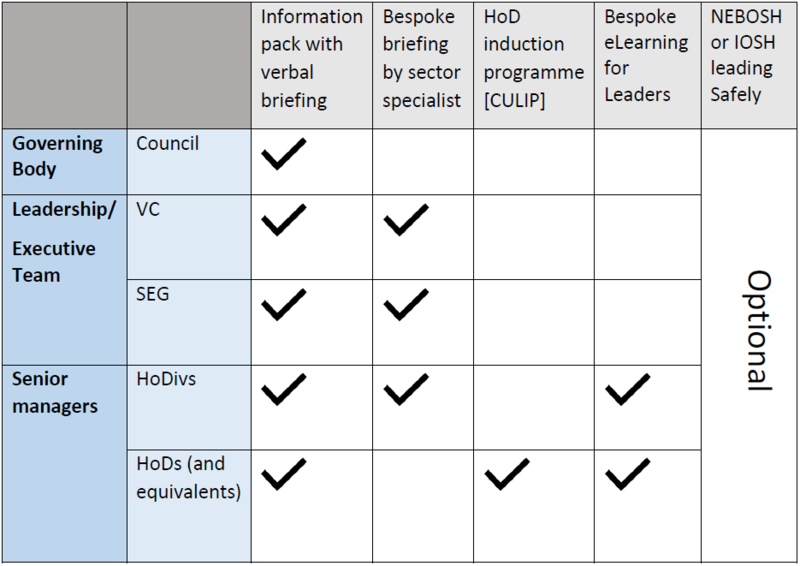
Below sets out how to access the different elements.
| Element | Delivery | Status |
|---|---|---|
| Information pack with verbal briefing |
Key information: Management responsibilities, Higher Education Management Standard
|
Please see above for Head of Department Health and Safety Briefing Pack |
| Bespoke briefing by sector specialist | The Safety Office is identifying suitable specialist and will arrange delivery in consultation with the Safety Executive Group (SEG) | Under development |
| Head of department induction programme | University Induction Programme, run by People and Organisational Development (POD) | H&S section included |
| Leaders bespoke eLearning | Health and Safety Training for Managers & Supervisors | Further bespoke training under development |
| NEBOSH (National Examination Board on Occupational Safety and Health) or IOSH (Institution of Occupational Safety and Health) Leading Safely |
NEBOSH HSE Certificate in Health and Safety Leadership Excellence |
Available for booking |

